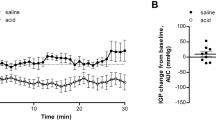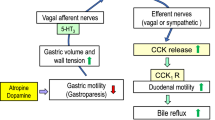Abstract
A model involving measurement of duodenal pH and acid-neutralizing capacity has been devised in anesthetized rats. A duodenal loop was made between the pyloric ring and the area just proximal to the outlet of the common bile duct (2 cm) and was perfused at a flow rate of 1.3 ml/min with HCl solution (1×10−4 M, pH 4.0) made isotonic with NaCl. The pH of duodenal perfusate was continuously measured using a pH glass electrode of the flow type, and the amount of acid neutralized in the loop was titrated to pH 4.0 using a pH-stat method and by adding 10 mM HCl. Under normal conditions, the duodenal pH was kept around 6.0 as the result of neutralization in the loop (∼9 μeq/hr). Subcutaneous administration of 16,16-dmPGE2 (10 μg/kg) significantly elevated the pH and increased acid-neutralizing capacity to 168.3% of normal levels. In contrast, indomethacin (5 mg/kg) and aspirin (200 mg/kg) as cyclooxygenase inhibitors or quinacrine (100 mg/kg) as a phospholipase A2 inhibitor significantly decreased both the pH and acid neutralizing capacity. After sacrifice with saturated KCl (intravenously), the pH decreased to 4.3±0.2 and the neutralizing capacity was reduced to 30% of normal values. Basal HCO3 − secretion in the proximal duodenum (∼5 μeq/hr), when titrated to pH 7.4, was significantly stimulated by 16,16-dmPGE2 and exposure of the mucosa for 10 min to 10 mM HCl. Neither indomethacin, aspirin, nor quinacrine had any effect on basal HCO3 − secretion, but all significantly inhibited HCl-stimulated HCO3 − secretion. These results suggest that endogenous prostaglandins play an important role in maintaining acid neutralizing capacity in the duodenum. The present system could be useful for screening drugs which may influence acid neutralizing capacity in the duodenum and for investigating the mechanisms of duodenal HCO3 − secretion underin vivo conditions.
Similar content being viewed by others
References
Flemström G, Garner A: Gastroduodenal HCO3 − transport; characteristics and proposed role in acidity regulation and mucosal protection. Am J Physiol 242:G183-G193, 1982
Flemström G, Garner A, Nylander U, Hurst BC, Heylings JR: Surface epithelial HCO3 − transport by mammalian duodenumin vivo. Am J Physiol 243:G348-G358, 1982
Flemström G, Turnberg LA: Gastroduodenal defense mechanisms. Clin Gastroenterol 13:327–354, 1984
Heylings JR, Garner A, Flemström G: Regulation of gastroduodenal HCO3 − transport by luminal acid in the frogin vitro. Am J Physiol 246:G235-G242, 1984
Konturek SJ, Bilski J, Tasler J, Laskiewicz J: Gastroduodenal alkaline response to acid and taurocholate in conscious dogs. Am J Physiol 247:G149-G159, 1984
Whittle BJR, Higgs GA, Eakins KE, Moncada S, Vane JR: Selective inhibition of prostaglandins production in inflammatory exudates and gastric mucosa. Nature 284:271–273, 1980
Oyanagi Y: Antiinflammatory effects of polyamines in serotonin and carragenan paw edemata—possible mechanism to increase vascular permeability inhibitory protein level which is regulated by glucocorticoids and superoxide radicals. Agents Actions 14:228–237, 1984
Adler RS, Gallagher GT, Szabo S: Duodenal ulcerogens, cysteamine and propionitrile decrease duodenal neutralization of acid in the rat. Dig Dis Sci 28:716–723, 1983
Ohe K, Okada Y, Fujiwara T, Inoue M, Miyoshi A: Cysteamine induced inhibition of acid neutralization and the increase in hydrogen ion back-diffusion in duodenal mucosa. Dig Dis Sci 27:250–256, 1982
Simson JNL, Merhav A, Silen W: Alkaline secretion by amphibian duodenum. I. General characteristics. Am J Physiol 240:G401-G408, 1981
Cooke AR: The glands of Brunner.In Handbook of Physiology, Alimentary Canal. CF Code (ed). Baltimore, William & Wilkins, 1967, pp 1087–1095
Flemström G: Stimulation of HCO3 − transport in isolated proximal bullfrog duodenum by prostaglandins. Am J Physiol 239:G198-G203, 1980
Konturek SJ, Tasler J, Bilski J, Kania J: Prostaglandins and alkaline secretion from oxyntic, antral and duodenal mucosa of the dog. Am J Physiol 245:G539-G546, 1983
Smeaton LA, Hurst BH, Allen A, Garner A: Gastric and duodenal HCO3 − transportin vivo; influence of prostaglandins. Am J Physiol 245:G751-G759, 1983
Takeuchi K, Ohtsuki H, Okabe S: Mechanisms of protective activity of 16,16-dimethyl PGE2 and acetazolamide on gastric and duodenal lesions in rats. Dig Dis Sci 31:406–411, 1986
Nobuhara Y, Takeuchi K: Possible role of endogenous prostaglandins in alkaline response in rat gastric mucosa damaged by hypertonic NaCl. Dig Dis Sci 29:1142–1146, 1984
Nobuhara Y, Ueki S, Takeuchi K: Influence of prednisolone on gastric alkaline response in rat stomach; a possible explanation for steroid-induced gastric lesion. Dig Dis Sci 30:1166–1173, 1985
Briden S, Flemström G, Kivilaakso E: Cysteamine and propionitrile inhibit the rise of duodenal mucosal alkaline secretion in response to luminal acid in rats. Gastroenterology 88:295–302, 1985
Takeuchi K, Ohtsuki H, Okabe S: Role of HCO3 − secretion in the etiology of duodenal ulcers induced by mepirizole in rats. Gastroenterology 86:1276, 1984
Lanza FL: Endoscopic studies of gastric and duodenal layers after the use of ibuprofen, aspirin and other non-steroidal antiinflammatory agents. Am J Med 77:19–24, 1984
Takeuchi K, Furukawa O, Tamaka H, Okabe S: A new model of duodenal ulcer induced by indomethacin plus histamine in rats. Gastroenterology 88:1606, 1985
Author information
Authors and Affiliations
Rights and permissions
About this article
Cite this article
Takeuchi, K., Furukawa, O., Tanaka, H. et al. Determination of acid-neutralizing capacity in rat duodenum. Digest Dis Sci 31, 631–637 (1986). https://doi.org/10.1007/BF01318695
Received:
Revised:
Accepted:
Issue Date:
DOI: https://doi.org/10.1007/BF01318695




